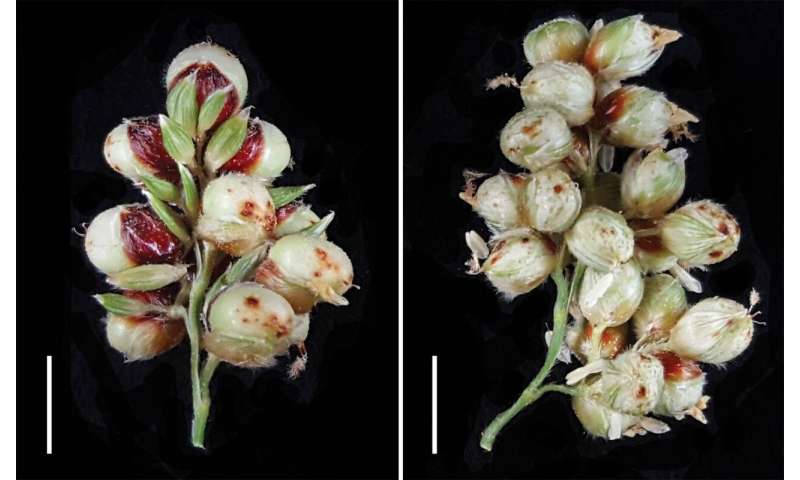
The left image shows the grains of a normal sorghum plant. The right image depicts how the amount of grains doubled in the genetic variant. Credit: Ware lab/CSHL, 2019
Plant scientists at Cold Spring Harbor Laboratory (CSHL) and USDA's Agricultural Research Service (ARS), in their search for solutions to global food production challenges, have doubled the amount of grains that a sorghum plant can yield.
Sorghum, one of the world's most important sources of food, animal feed, and biofuel, is considered a model crop for research because it has a high tolerance to drought, heat, and high-salt conditions. Increasing the grain yield has become even more important to plant breeders, farmers, and researchers as they try to address and overcome food security issues related to climate change, growing populations, and land and water shortages.
Led by Doreen Ware, CSHL Adjunct Professor and research scientist at the U.S. Department of Agriculture, and USDA colleague Zhanguo Xin, Ph.D, the research team identified novel genetic variations that occurred in sorghum's MSD2 gene, increasing the grain yield 200 percent. MSD2 is part of a gene line that boosts flower fertility by lowering the amount of jasmonic acid, a hormone that controls the development of seeds and flowers.
"When this hormone is decreased, you have a release of development that does not normally occur," said Nicholas Gladman, a postdoctoral fellow in Ware's lab and first author on the study, recently published in The International Journal of Molecular Sciences. "That allows for the full formation of the female sex organs in these flowers, which then allows for increased fertility"
MSD2 is regulated by MSD1, a gene discovered by Ware's team last year. Manipulating either gene increases seed and flower production.
"Major cereal crops are very close to each other evolutionarily. A lot of the genes that they share have similar functions," said Yinping Jiao, a postdoctoral associate in the Ware Lab and an author on the study. "This gene that plays an important role controlling the sorghum yield may also help us improve the yield of other crops like maize or rice."
Ware's lab uses this type of genetic research to understand how plants have changed over time.
"These genetic analyses actually give us the molecular mechanisms that provide more opportunities to engineer crops in the future," she said.
Explore further
The secret to tripling the number of grains in sorghum and perhaps other staple crops
More information:
Gladman et. al, "Fertility of Pedicellate Spikelets in Sorghum is Controlled by a Jasmonic Acid Regulatory Module" appeared in The International Journal of Molecular Sciences on October 8, 2019.
Citation:
Researchers double sorghum grain yield to improve food supply (2019, October 30)
retrieved 30 October 2019
from https://phys.org/news/2019-10-sorghum-grain-yield-food.html
This document is subject to copyright. Apart from any fair dealing for the purpose of private study or research, no
part may be reproduced without the written permission. The content is provided for information purposes only.
#Biology | https://sciencespies.com/biology/researchers-double-sorghum-grain-yield-to-improve-food-supply/
No comments:
Post a Comment